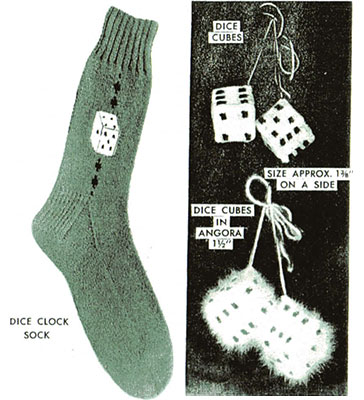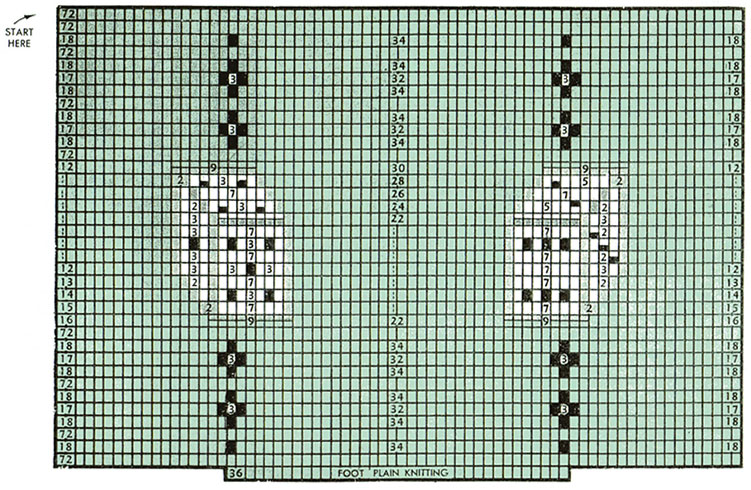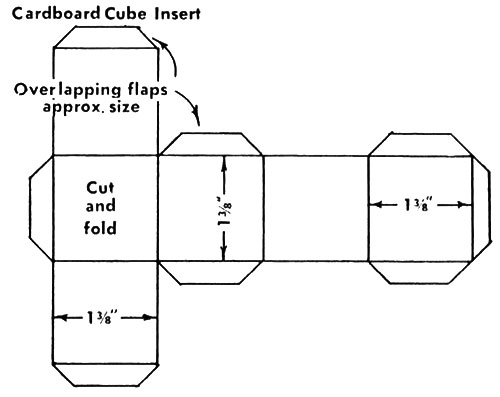Dice Clock Socks Pattern #7272

Simplified multi-color knitting with color charts. Stitch sequences numbered. Each row knitted across and purled back in the same colors.
Knit right and left socks, if you wish. Sizes 10 to 13.
IMPORTANT
Knit across and purl back each row before starting next row. Use size NUMBER ONE needles. Knitting tension should be tight enough to produce about 10 stitches per inch. If you do not obtain this gauge, then change to larger or smaller needles as your particular knitting tension requires. The size needle does not matter as long as the stitch gauge attained is correct. Note: 10 stitches per inch means 'as knit', without allowance for blocking. Socks then block to about 9 stitches per inch on usual size dryers, and will cling snugly to the average size leg when worn. For a very small size leg (such as 7 inches around above ankle) you may wish to knit to a tighter tension gauge than mentioned above, using the smallest possible needles. Use your own choice of yarn colors.
NOTES—(SOCK PATTERN)
1. In choosing yarn be sure colors selected are in good contrast to show the design in sharp detail. Most any dark or vivid color will be satisfactory as a background for the WHITE dice. Use a light color for the edges of the cubes to show their shape but not to detract from the WHITE faces and DARK spots on the dice, which should stand out prominently. Suggested alternate colors: Dark or bright BLUE sock with GREY outlines of WHITE cubes; BROWN sock with BEIGE or YELLOW outlines. Dice could also be knit in bright colors with alternate color spots if you wish. For example: RED dice on a DARK GREY sock with soft BLUE outlines for cube edges, and WHITE for the spots and clock marks as shown above in BLACK. (Or use these same colors on a LIGHT GREY sock with BLACK for dice spots and clock marks.) Dice may be knitted in ANGORA for an interesting effect but the sharpness of the design will be affected. WHITE or COLORED ANGORA could be used just for the spots if desired.
2. On rows 13, 17 and 25 the stitches representing the GREY horizontal edges of the dice cubes are purled back in a different color, to make these edges narrower, thus producing finer detail in the design. Similarly, certain of the BLACK spots on the dice are also made up of half-squares in which the purled back stitch is a different color from the knit stitch. These half-squares are readily identified by the colors on the pattern. Full directions are given on reverse side under "PURL-BACK VARIATIONS."
NOTE—REGARDING DICE CUBE PATTERN
Knit DICE CUBES in usual manner as a flat piece. Knit across and Purl back EACH ROW before starting next row. Size of cube will depend entirely on your stitch gouge. For a cube approximately 1⅜" on a side, knit 10 stitches per inch using your #1 sock needles. After 10 rows, bind off 14 stitches on each end and continue down pattern using the center 14 stitches. When completed, finish wrong side of work by tying and weaving-in yarn ends, trimming final ends etc. Then carefully steam press and shape work into proper symmetrical flat piece. Fold and press creases in cube on fold lines. Sew edges together to form a box and insert a cardboard cube carefully prepared with sharp edges as described on reverse side. Work should stretch slightly over this cardboard cube to present a neat, well-done appearance.
If ANGORA is used for the dice the 100% French Angora is recommended since it is the fuzziest. Some brands of this yarn are quite heavy in texture and might make the cubes too large to be attractive. If you do not obtain the proper stitch gauge, the lighter Angora may be obtained by untwisting one ply of the yarn and then knitting with the part remaining.
DIRECTIONS
(Directions herein are complete, including recommended methods for heel and toe. Free detailed instructions for beginners on how to knit, purl, etc., should be obtainable from the shop where yarn is purchased.)
MATERIALS—(Note: Different brands of yarn vary in yardage. The following yarn quantities for an average size pair of socks are approximate only.) 2½ oz. basic color green, 6 yds. grey, 6 yds. white, 20 yds. black. Socks illustrated are 7 inches long above top of heel, including 2 inches of ribbing. If longer or shorter socks are desired, change length of ribbing or number of plain rows at the top. In changing length, clock marks may be added-in, or omitted as desired. Use size No. One sock needles, double pointed, and regular 3-ply sock yarn.
IMPORTANT (Handling Yarn)—Use needles and yarn in the above accurate sizes in order to have sock of proper size per this pattern. Knitting tension should produce 10 stitches per inch. Use BOBBINS to carry your yarn in small quantities of each color. These will dangle clear of your work, avoiding entanglement. For certain small areas of color involving only a few stitches, you may prefer to merely use SHORT STRANDS of yarn, 12 to 15 inches long, dangling free, instead of bothering to wind separate bobbins. RECOMMENDATION—Make free use of additional bobbins or short strands as new color groups are encountered. A given strand will often be used over again for stitches in the same color group in the following rows, so be sure it is started long enough for the color group it is to handle. CAUTION—It is not desirable to carry one color yarn across the wrong side of another color, to reach stitches of the same color farther along the row. This would save extra strands of yarn, but in so doing the tension variation is likely to cause distortion of the stitches and thus spoil the clarity of the design. In some cases this carry-over of yarn can be accomplished satisfactorily across only one or two stitches of another color, where design detail is not too critical. Some experienced knitters can carry yarn across even more than 2 stitches and avoid a loose loop on inside of sock by twisting the yarn carried with the yarn being worked, but the danger of design distortion must be considered. You will have a more beautiful finished article if separate strands are used freely. The only inconvenience is a few more yarn ends to take care of in finishing inside of sock.
RECOMMENDATION ON BOBBINS FOR THIS PATTERN. Use 3 bobbins of background color for the 3 principal areas as separated by the 2 dice. Use a separate bobbin of white for each die, and preferably a separate strand for each face of the die, so that yarn is not then carried across the single grey outline stitches with a chance of design distortion. Use separate short strands for the black clock marks and also for each outline edge of dice, as shown in grey. A total of 5 bobbins will suffice (3 green, 2 white) plus the short strands.
PURL BACK VARIATIONS—You will note that on rows 13, 14, 16 to 20 inclusive, and No. 25, certain stitches, as shown by squares, are divided in half and colored accordingly to form finer detail in the design of the dice (showing them as cubes). This means that you do NOT purl these particular stitches back in the same colors they are knit, but change to the new color as indicated. Thus for row No. 13: knit the first sequence of 12 green stitches, then 9 more green (divided squares), 30 green … etc., (green completely across in this case). In purling back; purl 12 green, 9 grey (divided squares), 30 green, 9 grey (divided squares), 12 green. Similarly handle the divided squares representing other edges of dice cubes on rows 17 and 25; and also those divided squares for certain of the black spots. These variations apply to these few rows only. All other rows are to be purled back in exactly the same colors knitted.
LEG PATTERN—This part of sock is knitted in a flat piece, eventually to be folded and sewed together up the back. The successive rows on the pattern are knitted in order from left to right and each row is purled back. Each pattern row thus represents 2 rows of usual knitting. First cast on 72 stitches of basic color and knit 2, purl 2, for ribbing for 2 inches. Knit the first 2 rows of pattern plain and purl each row back to the beginning before starting next row. Knit the 3rd row, as shown on graph, that is 18 green, 1 black, 34 green, … etc. to end of row. These numbers are indicated on graph to save counting squares. In changing colors always twist yarns around each other once to avoid leaving a hole. Now turn and purl back on THIS SAME ROW using the same colors in the same places. Now knit row No. 4 in the indicated color sequence, a plain row in this case, and purl back as before. Continue knitting the successive rows in this manner using the color sequences indicated on the graph. After row No. 36 the work separates to knit the heel. Divide the 72 stitches, taking 18 off each end and place on a separate needle for the heel. In so doing the leg of the sock is folded into position for sewing up the back later. Leave the 36 center stitches on one needle and discontinue work thereon while doing the heel.
HEEL—(Reinforced type) Using the 36 heel stitches, slip 1, knit 1 in sequence for the first row, then purl back. Continue thus in successive rows for 2 inches. On the last purl row, purl 20 stitches, then purl 2 together, purl 1 and turn work.
Then:
Knit back 6, knit 2 together, knit 1, turn.
Purl back 7, purl 2 together, purl 1, turn.
Knit back 8, knit 2 together, knit 1, turn.
Purl back 9, … etc.
Knit back 10, … etc.
… Etc.
Continue in this manner, advancing the number of stitches worked at each end in this order, and thus making rounded bottom of heel, until all stitches are used, work then being all on one needle across bottom of heel. Now pick up stitches along the forward edges of the heel thus knitted, and add to the work in progress. About 21 or 22 stitches should be picked up on each side of the 2-inch long heel, and all of these heel stitches should be evenly divided on 2 needles.
INSTEP—At this point the entire sock is on three needles, consisting of the instep needle with the 36 center stitches (which must be kept separate), and the two underfoot needles on which the stitches along the edge of the finished heel are evenly divided. Now use a 4th working needle and knit the plain color foot round and round as with plain socks, and at the same time form the triangular gusset which widens the ankle, by decreasing 1 stitch at the forward point of each underfoot needle ON EVERY OTHER ROW until only 18 stitches remain on each underfoot needle. You will probably decrease 13 or 14 times depending on whether 21 or 22 stitches were picked up along the heel edge. Continue knitting the foot without further decreasing until 2½ inches from the desired length of the foot.
TOE—Now start decreasing to shape toe, as follows: Decrease 4 stitches on the next row, these being the end stitches on the instep needle, and the stitches next to these, one on each under-foot needle. Knit 4 rows plain then 1 row decreasing 4 stitches as before, 3 rows plain, 1 decreasing, 3 plain, 1 dec., 2 plain, 1 dec., 2 plain, 1 dec., 1 plain, 1 dec., then decrease every row until only 16 stitches remain (8 on instep needle and 4 on each underfoot needle.) Weave toe as follows: Place yarn in a tapestry needle and, with yarn coming from back of knitting needle, put it in first stitch of front (instep) needle as if to knit and slip it off. Then put it in the next stitch of front needle as if to purl and leave it on. Go to back (underfoot) needle and insert as if to purl and take it off, then to next stitch of back needle as if to knit and leave it on. This designation may assist:
Front needle K—off P—on
Back needle P—off K—on
Repeat thus to the end of the 8 stitches on each needle.
FINISH—Sew sock up the back, using corresponding color of yarn and tapestry needle. Finish inside of sock by weaving any thread ends into nearby seams, trimming ends, etc. Block socks on dryers of proper size.
DICE CUBES: Materials (2 cubes)—In regular sock yarn, ¼ oz. white, 5 yds. black; in 100% white Angora, 14 grams, or less than ½ oz. These are knit in a flat piece in same manner as pattern part of a sock. After pressing the completed work to a neat symmetrical shape, the edges are sewed together to form a box, using a strand of same color yarn (not Angora) on a tapestry needle. Before closing and sewing final cover on this dice-cube (box), insert a cardboard cube cut in size to fit snugly into your empty dice cube. Cut cardboard as shown by diagram, 1⅜ inches on a side will be correct if your work has been knit to proper 10-stitches-per-inch gauge. Use light cardboard as from a suit box. Score (on outside) with sharp knife or razor blade, the edges of cardboard that are to be folded, so they will fold into a nice sharp edge. Fasten overlapping flaps in place with Scotch tape so box will hold its shape. Fill box with shredded paper or other padding, to give it some weight. After inserting boxes into your knitted dice, sew to final edges and attach strands of yarn to one corner of each die for use in hanging up these cubes.
GENERAL DIRECTIONS
Each square equals one stitch, knitted and/or purled. Sequences of stitches in particular colors to form a pattern are shown in color and by numbers on the specific pattern graphs. This saves counting squares. The number of rows and number of stitches in each, depend on the symmetry of the pattern design, also on the approximate size of sock desired in order to fit the wearer's leg. Size and dimensions are indicated in each particular pattern.
Each row is normally knitted and purled back in the same colors. For certain patterns which are easily repeated, the knitter may, in purling back, go to the next row. In this case the indicated pattern will be reduced in size by one-half, and the entire pattern must then be repeated in order to achieve the length indicated. Heel, bottom of foot, and toe are knitted in the manner of plain socks. In certain patterns where the instep is a plain color, and the same color as the foot, this part of the sock may be knitted round and round as in plain socks.



| Pattern Categories Browse the categories to help you find the patterns you're looking for. |
||
|
||










